The
Sassoon's Return Visit to Baghdad
A
Diary by Mozelle Sassoon
In
September 1910 Mrs Farha Sassoon and her children undertook
a trip from Bombay to Baghdad via Basrah.
On
the voyage to Basrah, they were joined by Sir William Willcocks
in Karachi, who built the Asswan Dam in Egypt.
On
the way to Baghdad, they stopped at Ezair to visit the Shrine
of Ezra the Scribe (Ezra Ha-Sofer).
Flora’s
daughter, Mozelle Sassoon (1884-1921) kept a detailed diary
of the whole journey, which continues:-
Tuesday,
27 September –
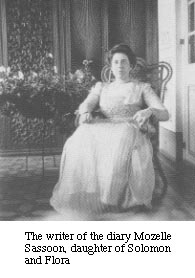 Before
entering Baghdad we saw the bridge of boats which opens
and closes to let river traffic through. As we were going
in the balam, we passed Aunt Hannah’s house and saw
her on the veranda with several members of her family, and
her daughter Rebecca Daniel was looking through her binoculars.
Lynch’s Baghdad agent took us through two narrow lanes
to our house, rented from Mr Fatoohi for £55 for two
months. It seems that Mr Fatoohi went to Bombay for a change,
and in his absence his son spent all their money in building
this huge palace in very grand style. The drawing-room ceiling
and the bedroom walls and doorways were elaborately decorated
and coloured glass decorations were used in the verandas.
The house costs £5,000 that made the poor father lose
his reason.
Before
entering Baghdad we saw the bridge of boats which opens
and closes to let river traffic through. As we were going
in the balam, we passed Aunt Hannah’s house and saw
her on the veranda with several members of her family, and
her daughter Rebecca Daniel was looking through her binoculars.
Lynch’s Baghdad agent took us through two narrow lanes
to our house, rented from Mr Fatoohi for £55 for two
months. It seems that Mr Fatoohi went to Bombay for a change,
and in his absence his son spent all their money in building
this huge palace in very grand style. The drawing-room ceiling
and the bedroom walls and doorways were elaborately decorated
and coloured glass decorations were used in the verandas.
The house costs £5,000 that made the poor father lose
his reason.
Soon
after we arrived, Hakham Nessim Ben Abu-Reuben arrived and
the latter brought a tray with 12 cones of sugar of which
we are told it is the rule to take one or two only and return
the rest with one or two plates of sweets or other dainties.
Aunt Hannah came soon after and lots of other visitors kept
on coming the whole morning; among them Abdel Kader Pasha
al-Khetheiry. He sent us a big Mosul earthenware chatty
(Hebb) for purifying and cooling the water.
 In
the afternoon visited us Chief Rabbi David Papu, Hakham
Moshe Shamash, Hakham Abraham Hillel, Hakham Yitshaq Abraham
Mjaled. It was a wonderful group; they are all so handsome
and all have snowy white hair, as well as Hakham Ezra Dangoor
Hayyu and Hakham Yaacob Yoseph Hayeem and others. David
Basoos has sent Ezekiel Saltoun to be our buyer of provisions
(meswaqchi) and shohet for us. Mr Langridge, Lynch’s
agent, says one watchman will be quite enough and he will
act as a servant, as Baghdad is quite safe and he can sleep
at night.
In
the afternoon visited us Chief Rabbi David Papu, Hakham
Moshe Shamash, Hakham Abraham Hillel, Hakham Yitshaq Abraham
Mjaled. It was a wonderful group; they are all so handsome
and all have snowy white hair, as well as Hakham Ezra Dangoor
Hayyu and Hakham Yaacob Yoseph Hayeem and others. David
Basoos has sent Ezekiel Saltoun to be our buyer of provisions
(meswaqchi) and shohet for us. Mr Langridge, Lynch’s
agent, says one watchman will be quite enough and he will
act as a servant, as Baghdad is quite safe and he can sleep
at night.
Wednesday,
28 September –
A
few visitors came very early. Among them Hakham Sasson Smooha
Hayyu, a previous Chief Rabbi and Saleh Elyshaa. Meir Somekh,
only surviving brother of Moreno (Stayee) Hakham Abdullah
Somekh also called.

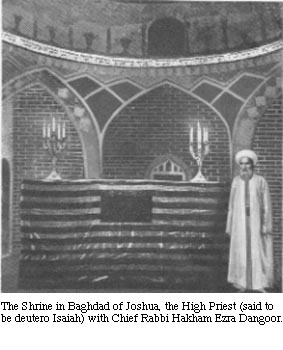 Thursday,
29 September –
Thursday,
29 September –
We
went to Midrash Talmud Torah School to examine three classes
in Hebrew dictation and grammar. Hakham Ezekiel of the Alliance
School looks after it all. The Chief Rabbi who presided
at the examination was there as well as Hakham Sasson Smouha.
Then we went on the balcony (Tarma) and saw the boys assembled
in the courtyard, and David took a snapshot of them. They
sang Turkish and Arabic songs and Hakham Ezra Dangoor made
a Meshabairakh and Mamma promised them Turkish £20
for a poultry dinner for the boys. The children were all
in new khaki suits given by the Wali,costing T£50
and we saw some suits being made there.
Today
Hakham Abraham Dangoor and Hakham Ezra Cohen called.
At
6.30 we ordered a landau and drove to Bab-el-Shargee. Mr
Saul E. M. Hayeem came as a guide. It was a drive through
narrow lanes and bazaars, across awful roads full of holes
and ditches, and dust was like a fog around us. Bab-el-Shargee
(South Gate) is a big plain with some trees in the distance
– and forms the Hyde Park or Bois of Baghdad. On the
return journey we drove through Menahem Salman Daniel’s
bazaar – he used to let it and the government arranged
with him that if he died without leaving any children that
they would take it. He was the husband of Rebecca, Aunt
Hanna’s daughter. After he died in 1891 the bazaar
was taken over by the government. After that we passed the
Serai by an asphalt road, and many cafés, which are
brightly lit up. Nearly everyman in Baghdad spends the evenings
at the cafés. We had innumerable visitors again today.
Abdel-Kader Pasha invited David to go for a drive with him
tonight, so he met him near the café and went for
a drive in the same hired landau that we had, and ended
off at his house, where there were singing and dancing in
the drawing room, by Jewish actresses
and Mohamedean actors.
 Friday,
30 September –
Friday,
30 September –
We
got up very early and were ready to go to Yehoshua Kohen
Gadole (Joshua the High Priest). We had to cross the river
by balam, as the bridge was open to let the Hamidiya, (the
boat we came on) to get through on its return journey. On
the other side (Hathak-el-Sob) two landaus were awaiting
us. We drove to the Shrine accompanied by Saul Hayeem through
a dusty barren desert – just a quarter hour’s
drive. This building is quite small. We took off our shoes
and went inside and we hooked on the tomb the covering that
we brought with us and put as well the bells on each corner.
We lit candles and David and Saul Hayeem read the Kaddish
and David read the Hashkaba for Papa. We could only read
Shama’a-na Yehushua around the dome; the rest was all
effaced and the whole place was spoilt when the Turks took
possession of it in 1891; but now the new Wali is going
to give it back to them. On our way back, we passed Zobeida,
Haroun-el-Rashid’s favourite wife’s tomb, which
is pineapple shaped.
When
we got back we found that D. Bassouses had sent us jeradeq
and Shabbath bread.
Saturday,
1 October –
We got up early. David went before us to the Great Synagogue,
where the service began at 5.30 and we got there at 6.30
accompanied by Ezekiel Saltoun, our steward, who had already
finished his prayers at an earlier Synagogue. We were conducted
up to the ladies’ gallery behind the Tebah, where we
had seats arranged for us by Mrs David Basoos. All the ladies
were covered with their Ezzegh and Khwili and it was impossible
to make them up; they all sit on the floor, and it is such
a tight fit. They all crowded around us, and in the afternoon
a visitor told us that it was not only to see us, but to
study the latest fashions also. The gentlemen prayed in
the open courtyard, without any roof, which they generally
use in the 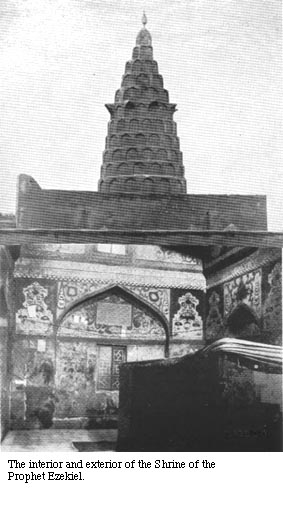 summer,
and behind is the covered Synagogue, which is used during
the winter or when the service is going to be late and it
will be sunny. The service was conducted by Hakham Ezra
Dangoor himself, his Hazzanouth is considered the best in
the country. The Synagogue was simply packed. There were
26 Hekhaloth. David was called up to the Sefer, (Saleh Elishaa
Sassoon gave his turn to him, as he always read it) and
made a Meshabairakh of T £2 and they did the Hashkaba
for dear Papa Solomon David Sassoon. Prayers were over at
7.15. Here the Hazzan reads the whole Parasha – only
the Maftir is read by the Olé and all the Congregation
join in the Haftara so that the principal reader’s
voice is not heard.
summer,
and behind is the covered Synagogue, which is used during
the winter or when the service is going to be late and it
will be sunny. The service was conducted by Hakham Ezra
Dangoor himself, his Hazzanouth is considered the best in
the country. The Synagogue was simply packed. There were
26 Hekhaloth. David was called up to the Sefer, (Saleh Elishaa
Sassoon gave his turn to him, as he always read it) and
made a Meshabairakh of T £2 and they did the Hashkaba
for dear Papa Solomon David Sassoon. Prayers were over at
7.15. Here the Hazzan reads the whole Parasha – only
the Maftir is read by the Olé and all the Congregation
join in the Haftara so that the principal reader’s
voice is not heard.
On
our way back Mrs Basoos insisted on our stopping at her
house for a few minutes. They showed us their Sirdab, where
people spend the day during the great heat. It is a cellar.
Sirdab is a compound Persian word meaning "cold water",
it being the practice in these parts to keep cold water
stored in cellars. Then we went to Aunt Hannah’s house
where we saw the white Luzina tray and a pair of anklets
which was sent to her grand-daughter by her fiancé
on the occasion of their engagement.
It
was a tremendous tray. I am sure it must have measured a
few yards round and the Luzina was about 1/2 foot thick.
We tried to move it a little but could not; it was such
a deadweight, composed of sugar and almonds with cardamom.
They tell us such a tray costs from T£4 to T£5
and if a bride does not receive it, she feels hurt. It is
then distributed and the friends and relations are thereby
informed of the engagement. We then came home to breakfast,
and soon after the influx of visitors began. More came after
lunch. Mrs Semha Sasson Somekh of Amarah stayed on for tea
and Habdala. After prayers Hakham Nessim Ben Abu Reuben
stayed to dinner.
We slept on the roof for the first time. It was delightful
and the stars looked beautiful. So we tried the Sardab and
the roof on the same day. I had always wondered what sleeping
on the roof was like.
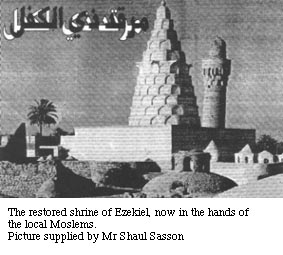 The
young ladies here do a lot of embroidery (broderie anglaise
and raised embroidery chiefly) and also embroider by machine,
The
young ladies here do a lot of embroidery (broderie anglaise
and raised embroidery chiefly) and also embroider by machine,
Sunday
2nd October –
After
breakfast at 8 we went in two landaus to Muadham by such
a dusty, shaking, bone-breaking drive through an immense
desert. On our return we passed Uweina, which is the place
where the milk come from, where they farm the cows, and
we drove through Abu Sifein where the poorest Jews live,
and Henouni, the shopping area. We got back at noon very
tired.
After
lunch Hakham Yaacob and Hakham Yoshua did the Hettara for
us.
At 6.15 Abdel Qader Pasha took us to the Wali Nazem Pasha,
Turkish governor of Baghdad. We ushered ourselves into his
presence on the Terrace. The Wali speaks only Turkish and
French and the Arabic was translated by Abdel-Qader Pasha.
The Wali is about 60 and has been only 5 months in Baghdad.
He showed us the plans made by a French architect, Goddard,
for a new gate for the Serai and other improvements thereabouts.
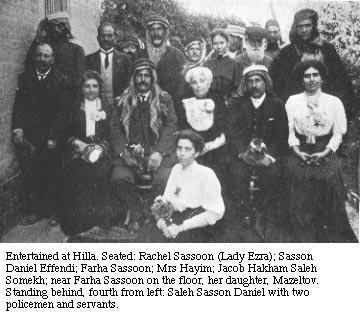 Monday,
3rd October – Eve of Rosh Hashana
Monday,
3rd October – Eve of Rosh Hashana
At 5.30 we all went to the Great Synagogue where we sat
by ourselves in a Hekhal on a side. The prayers were read
very quickly and not word by word as in Bombay.
At
home we read Mishna before dinner. Mrs Basoos sent us holy-day
bread and Saleh Elishaa Benjamin Sassoon sent us apple jam
for Yehi Rasson and two bottles of old kiddush wine which
we used tonight.
Rosh Hashona 5671 – Tuesday 4th October –
We
got up early and went to the Great Synagogue. Grandpapa,
Sheikh Sassoon’s Sefer was brought out as Sefer Rishon.
It is contained in a beautiful chased silver case "Tiq",
much tarnished with age. He dedicated it in the year 1793
and made a condition that it should be brought out first
for Kol Nidre and every holy-day including the Festivals
and Hol Hamoed and Shabbath Jethro, Beshallah and Weth’hannan
and one of the direct descendants from the paternal side
is to be called up to the Sefer and lights the Hanukkah
in the Synagogue. Our family here have the original document
in their keeping and it is signed by the Rabbis of those
days. A few years ago, others, among them Sassoon Hayeem
Moorad, wanted to do away with this time-honoured right
and use their Sefarim, but this document was produced, and
Hakham Yosef Hayeem also affixed his signature to it. (They
say the scroll got worn out and has been changed). The descendants
of Abu Reuben also have a right to sit in the middle Hekhal
which is the principal one and where our ancestor Sheikh
Sassoon sat. As a rule Saleh E.B. Sassoon exercises these
rights, and on this occasion he gave them all to David.
When they started the school service, Sasson Moorad and
others took his Sefer there. On our return we stopped at
Mrs Basoos to give the crowd time to diminish and got home
at about 10. David went to the Hathima to Saleh E. D. Sassoon’s,
quite near. They began at 11 and it lasted till 2. David
came home for lunch and went back. During the afternoon
many visitors called and stayed late. We read the Mishna.
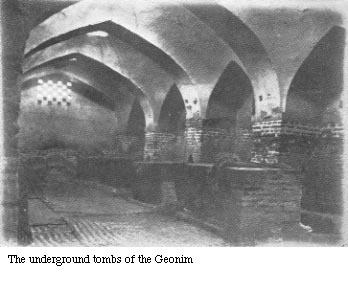 Wednesday,
5th October –
Wednesday,
5th October –
We
all went to the School Synagogue today, which building was
given by Grandpapa Sir Albert and has a wing given by Menahem
Saleh Daniel. The gentlemen prayed in the open courtyard,
which the children use as a playground. We sat on the veranda
near the Chief Rabbi’s wife. We got home at about 9.
It seems on Rosh Hashana people do not pay visits, but we
had heaps of calls, as they find us so "irresistible,
tempting and charming" as Farha’s sister said.
The Wali’s A.D.C. called with the Wali’s card,
but stayed only a few minutes as the influx of ladies was
so overpowering that he fled!
Thursday,
6th October –
This
morning soon after 8 we all went in two landaus to the Bab-el-Wustani
to see the Review of the troops in honour of the "Eed"
at the end of Ramathan as the Wali’s guests. We went
and took our seats in a large tent, lined in red, yellow
and blue. They brought sherbet and at about 9.30 we and
the others (3 European men, some Arab Sheikhs and some Turks)
went to a fenced-off enclosure, in front of which, the infantry,
cavalry and the artillery marched past. There were 4000
soldiers among them there being 450 Jewish conscripts. These
were all in khaki suits, with the Eguel on their heads,
the kerchief arrangement hanging down, protecting their
necks from the sun. They did not look well turned out and
marched badly. Some of the Arab ponies were very fine, but
did not look well-groomed. The band played some monotonous
tunes the whole time. Rachel and the others remained outside
walking about, and Mamma, David and I returned to the tent
after the parade. After a little while the Wali Pasha came
to the tent (he had been watching the review on horseback)
and shook hands with Mamma and me and salaamed all the gentlemen
and then sat down, and the gathering dispersed after a few
minutes. After the serving of rose coloured drinks. The
Chief Rabbi had also come while the Parade was going on,
with his son and when the Wali came he came forward to shake
hands, but he only salaamed all round. An Arab Sheikh had
been sitting near Mamma and talking to her and he told her
that she is "like a queen; she has so much information
and knowledge". Sheikh Saadoon, who has come to Baghdad
after 30 years, was there and had a seat of honour in the
centre of the Assembly. He has two hundred thousand followers
under his control and Sheikh Amir el Najd has two lacs (20,000),
and they are both very powerful chiefs.
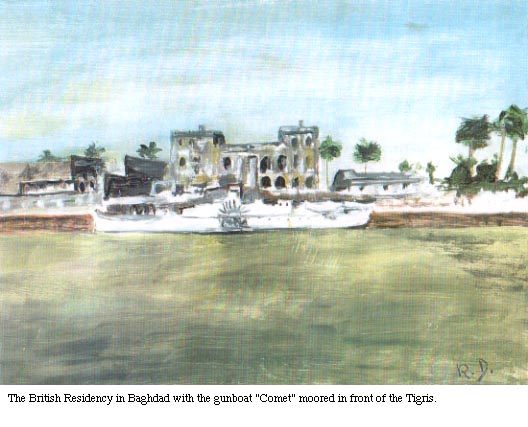
Painting by Renée
Dangoor
On
our way back we called on Hakham Jacob and his mother (widow
of Hakham Yosef Hayeem) at the family mansion near the Henouni
and we saw many members of the family there. We asked Hakham
Jacob to enquire if the Chief Rabbi was in and from there
we went to call on him. He said he had nothing good enough
to present to Mamma, so he would give her his photo as a
souvenir. He has had it taken in full dress, and then he
brought the coat to show us and put it on with his two orders.
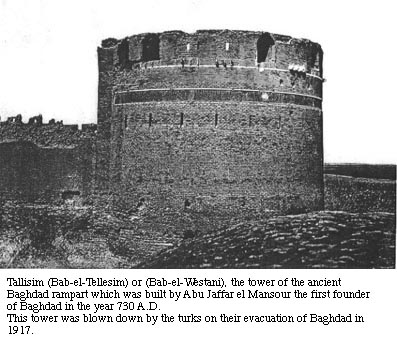 Friday,
7th October –
Friday,
7th October –
Today
we ate Za’arur which look something like cherries,
but are very insipid. There is a saying – Ja el za’arur
wa kassah el khairat (when za’arur comes it terminates
the fruit season).
Today we were all asked for tea at the English Club.
Mrs
Lorimer, the British Consul’s wife, who was there,
asked Mamma to her bi-monthly garden party tomorrow but
we are not going. (I am writing this on the 9th of December,
so after two months I cannot remember who dined with us).
Saturday, 8th October –
We
got up at 5 – and we all went to the Alliance School
Synagogue. The service was over at 7.15. After breakfast
Mamma, Rachel, David, Diana and I began by calling on Mr
and Mrs Menahem Saleh Daniel and Mr and Mrs Sasson Saleh
Daniel at their large double riverside mansion. Mr M D has
two orders from the Sultan Abdel Hamid and both the brothers
are known as Effendia. They have a pretty garden, in which
we saw oleanders (defla), roses, carnation trees and violet
plants. Mrs Rebecca Daniel is related to us. Menahem Effendi
had come to see us some days ago on his return from Hillah
and Mamma had a telegram from his son Ezra on Rosh Hashana.
He knew us in Bombay in 1900. Mrs Sasson Daniel and her
daughter Regina, a schoolgirl are very quiet, as also Mr
Sasson Daniel. Mrs Menahem and Mrs Sasson were both in Arabic
dresses with caps and scarves round the chin (Fez and Lachag),
but the former had an abaya over her head also; it is the
first time that I have seen it worn thus. It is customary
for ladies of good family to wear an abaya indoors and an
izzagh out of doors. She is very particular and when she
travelled to Europe and Egypt she had her cook with her
and would not even eat the Shehita of several places. Once
she went for her son’s health and once for her husband’s.
We then went to beit Abu Reuben which has an enormous courtyard
and used to be the finest and largest house in Baghdad,
but now it is in a sad condition, and quite void of its
splendours. Grandpapa, Sheikh Sassoon, the Nassi, lived
there over 100 years ago. A few branches of the family are
living there now. We had met Meir Somekh on the way and
Mamma told him to lunch with us today and he agreed, so
today suddenly we discovered lunchtime that he had left
after calling, and Mamma was so sorry that she had not told
him again (after a few days when we got to know him better
he told us he saw the fire in the kitchen and he could not
understand and did not like to ask, so would not eat here,
so Mamma explained to him that the Goy did it).
 Mr
and Mrs Yehouda Zelouf and their little girl , Flora, Hakham
Sasson Smouha, Mr Elias Elishaa and Mr Saul E. M. Hayeem
stayed to lunch here. During the afternoon we had a great
many callers. In the evening Diana went for a boat sail
with Hougui’s and Moshi’s families. After sunset,
Rebecca Menahem Silman called and asked Mamma to dine with
her tomorrow evening. Mamma tried to tell her that we could
not come, but she would not listen, so accepted.
Mr
and Mrs Yehouda Zelouf and their little girl , Flora, Hakham
Sasson Smouha, Mr Elias Elishaa and Mr Saul E. M. Hayeem
stayed to lunch here. During the afternoon we had a great
many callers. In the evening Diana went for a boat sail
with Hougui’s and Moshi’s families. After sunset,
Rebecca Menahem Silman called and asked Mamma to dine with
her tomorrow evening. Mamma tried to tell her that we could
not come, but she would not listen, so accepted.
Sunday,
9th October –
The
ex-German Consul called. He was charmed with the house and
said he had no idea there was one like it in Baghdad. The
headmaster of the Alliance School called and related to
us about his Babylon trip. He and 20 or 30 of the school
teachers went with, and Mrs Menahem and Mr and Mrs Sasson
Daniel as their guests. They went to Babylon and Kifil,
the site of Ezekiel’s Shrine. They had a delightful
fortnight.
After
a boat outing we went to Rebecca at 8 o’clock for a
large dinner party, We waited a long time, and we did not
know that Rebecca was waiting for us to say that we had
rested sufficiently and were ready for dinner. At last we
sat down at the table. There were some hired waiters and
also a "party cook".
The
menu was as follows:- soup, stewed fish (Shebbout), lamb
cutlets and green peas, tomato mahashas, home-fed roast
geese, rice pillau with raisins and almonds, gombo (okra
or bamia) stew and green beans stew and roly poly pudding.
Everything except the roast was made of mutton. It was a
very long menu. There were several kinds of sweets and preserves
and the fruit was very good. The plates were continually
changed, even between the fruits. We all walked home after11.
They sent a number of lantern bearers with us besides our
own men. Mamma told Rebecca it was a beautiful party and
she must have taken so much trouble over it. She said she
does not do a thing, the servants do everything in her house.
The flowers on the table were very pretty.
Monday,
10th October –
Today
we made return visits to many relatives and friends. In
the afternoon we had more callers at home.

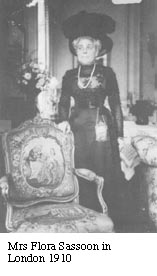 Tuesday,
11th October –
Tuesday,
11th October –
At
8.30 David went to see the Great Synagogue with Saleh Elishaa.
He has asked them to allow him to dig under the brickwork
to find some old records, which they buried there. They
have agreed and he is to build up the mounds again. At 9
Rebecca came over to say that Abdel Jabbar Effendi, the
greatest lawyer here, was coming to call and he arrived
at 9.30, accompanied by Shaoul Shashoua and Yosef Shemtob.
He, Abdel Jabbar is an Armenian. He went to Bombay with
Fatoohi our landlord, and before he had been there a week,
the Turkish Government wired to him to return at once, as
he had no business to leave without orders, because he has
a Turkish title!
We
drove to the Mosque of Sheikh Abdel Qader al Gailani in
Bab-el-Sheikh. We walked through the courtyard, but couldn’t
get in to see the tomb because of the crowd. Then we visited
the Izzagh factory nearby and ordered some abayas and ezzegh,
hand loomed of silk and gold thread with various designs.
At 5 we all drove to the British Consulate to tea with Mrs
Lorimer. There was a difference of 6 hours and 20 minutes
between the English time and the Turkish as the Turkish
is always 12 at sunset and the English have the sunset today
at 5.40. The house is very nice and is only built on three
sides of the courtyard, quite modern and on the river. We
went upstairs to the drawing room, and to our surprise we
found a real English drawing room, such as we had not seen
since leaving Bombay. After tea we went onto the verandas,
which are very large, then we went on to the roof and were
shown the roof room where they used to keep the beddings
during the hot daytime sun. They always sleep on the roof
and enjoy it. There was an Indian soldier there, who was
watching for the sunset, as he dips the flag every day at
sundown at the sound of the bugle. The Comet, an Indian
marine boat is stationed opposite. Mrs Lorimer said that
Sir W. Willcocks had been relating our Basrah experiences
to them. In the evening Jacob did the Kapparot for us on
the covered veranda near the kitchen. There is a scarcity
of white cocks this year and they are very expensive. Poor
Meir Eliahou is very ill and the operation does not seem
to have done him any good. He is so charitable and has done
so much good. During his illness, when they carried him
upstairs he gave T£5 mitzvah for every step; there
were about 20-24 steps.
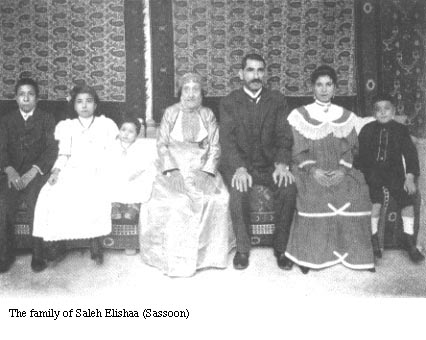 Wednesday,
12th October – Kippur’s Eve
Wednesday,
12th October – Kippur’s Eve
One
piece of news is that Mr Strauss, the American Ambassador
at Constantinople (whom Mamma met at Sir Samuel Montagu’s
dinner when we were at the Grosvenor Hotel in June 1906)
has abandoned his visit to Russia, having been refused a
privilege passport, because he is a Jew, and receiving only
the usual authorisation issued to Jewish merchants. They
subsequently ordered a special permit, but Mr Strauss declined.
At
the Great Synagogue they have a 110 years old Parokhet falling
to pieces which has a complete plan of the future third
Temple, which they bring out only on Yamim Noraim and Semhat
Torah. Hakham Yosef Hayeem A.H. who died last year wanted
it copied. I think David is going to buy it. On the eve
of Rosh Hashana and Yom Kippur all the Jews visit the cemeteries
after morning prayers and the poor people go to the different
houses and beg. On the eve of Rosh Hashana though we distributed
money they were so troublesome that today Jacob asked Abdel
Qader Pasha to send a soldier to stand at the door.
At 9.30 Mamma, Diana, Rachel and I with Hakham Nessim Ben
Abu Reuben (on the box) drove to see the Jewish Cemetery
(David had another appointment). We felt very sad to see
the shabbiness and struggling state of the whole place.
The community go on working their way eastwards, although
here is a vast plain westwards, which originally was the
site of the old graves, for fear of exhuming any bones.
The name is inscribed on the side where the head goes, and
is kept covered with a brick, which can be pulled out when
they wish to read the name. The graves are covered with
bricks and mud; they are afraid to use stones or marbles,
because the graves would be demolished and the materials
stolen. The poor Jews – how different are the English
and the Armenian cemeteries which have high boundary walls
and cypress trees.
End
of Diary
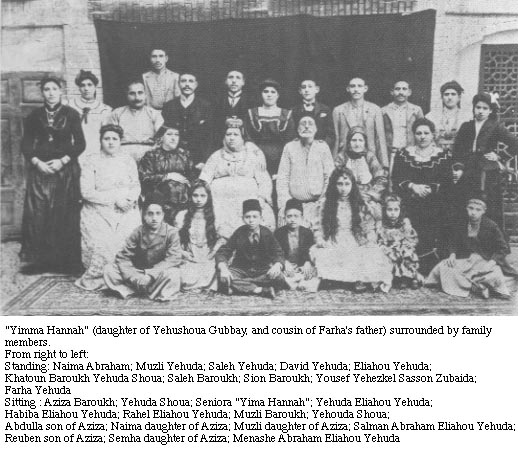
NOTES:
On
one occasion during the visits to Mrs Farha Sassoon, 6 Chief
Rabbis, past, present and future sat under one roof. It
is noteworthy that the visitors did not appear to having
been offered the Masgouf Shabbout fish of which Baghdad
is famous.
The
Turkish pound was a gold Lira worth at the time 12 Indian
Rupees or 18 Shillings. We greatly admire the scope and
interesting details in the Diary of Mozelle (1884-1921).
David Sassoon wrote his own diary which appeared in Hebrew
in a book entitled (Massa’a Babel).
Scribe:
In
the short space of 40 years, the following momentous event
happened in and around the region:-
The First World War (1914-1918)
The Russian Revolution (1917)
The Balfour Declaration (1917)
The Dissolution of the Austro-Hungarian Empire
The Dismemberment of the Ottoman Empire
Iraq given to Arab Rule (1921)
The emergence of 21 Arab countries, under Mandate
The Turkish Republic adopts the Latin alphabet (1923)
The rise of Nazi Germany (1933)
The Second World War (1939-1945)
The Farhud in Iraq, hundreds of Jews killed (1941)
The Holocaust (1942-1945)
The Independence and Partition of India (1947)
The creation of the State of Israel (1948)
The discovery of vast oil reserves in Arab countries
The forced emigration of about a million Jews from Iraq
and other Arab countries (1950)
In
1910, the safest way to travel from London to Baghdad would
have been by sea to Bombay and from there to Basrah by local
steamer and from Basrah to Baghdad by riverboat, totalling
5 weeks
In 1950, regular airlines took only 5 hours from London
to Baghdad.
The
Expelling of Nazem Pasha - The Wali of Baghdad
In March 1911, Nazem Pasha received an order from Istanbul
terminating his appointment as Governor of Baghdad. There
was a public outcry against this order and, despite a wave
of strikes and hunger strikes in support of the popular
Wali, Istanbul refused to rescind the order and he was replaced
by a new Governor Yousef Pasha.
If
you would like to make any comments or contribute to The
Scribe please contact
us.